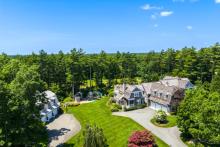Closing arguments prepared for Marion's solar bylaw
Residents rely on municipal board recommendations to make informed decisions at Town Meeting, and Marion Planning Board members are scrambling to prepare one for a solar bylaw that has proved contentious.
The planning board charged solar subcommittee members Stephen Kokkins and Rico Ferrari to weigh the pros and cons of a commercial solar farm provision.
As written, the bylaw limits solar farms to sites with three or more acres of land in any residential zone, which encompasses more than 90 percent of Marion. Some planning board members called for scrapping that part of the bylaw in favor of creating an overlay district. Such a district would prevent solar farms from operating outside of the overlay.
On Wednesday afternoon, Ferrari and Kokkins met to pin down their arguments for and against including solar farm language in the bylaw. Energy Management Committee member Jennifer Francis also attended to offer advice and advocate for approving the bylaw at Special Town Meeting.
In May, Annual Town Meeting voters narrowly defeated a committee-drafted bylaw that sought to regulate placement of ground-mounted, and roof-mounted solar panels for resident use.
The board has worked with the energy committee to draft a bylaw that both groups can agree on; however, language regarding solar farms is still an unresolved matter.
Previously at odds, the energy committee and the planning board decided it would be best if one bylaw, supported by both boards, were presented to voters. Following compromises on solar arrays for personal use, the energy committee withdrew a separate bylaw they drafted.
For the past two months, the solar bylaw discussion has consumed much of the board’s time. Board members, and residents, have expressed concern over allowing a commercial operation in a residential area.
“Personally, many people have told me that they are quite uncomfortable with having commercial operations of any kind in residential areas,” Kokkins said. The overlay district, he noted, would restrict commercial farms to certain areas while also proving that the town is making progress on renewable energy.
He said he favored striking the solar farm provision for the meantime. Over the winter, the planning board should research an overlay district and present a bylaw to be voted on at Annual Town Meeting in the spring.
Francis said the current bylaw already affords the town broad powers to deny a solar farm if its location was deemed unsuitable. Before a solar farm could open, a developer would need to undergo a comprehensive review process. The bylaw has several conditions, including screening the panels from view, that must be met before the planning board could sign off on a solar farm. Also, Francis noted the town’s geography would only support about a half a dozen solar farms – most likely, that number is lower, she said.
The board has three options to recommend to voters. The first option would be to reject the entire bylaw, though doing so would scrap rules governing the placement of solar panels for non-commercial use; the second recommendation would be to approve the bylaw as it is; and the final option would be to nix the solar farm language in favor of revisiting the issue in the spring.
Kokkins and Ferrari decided to break the problem into smaller parts. Ferrari will prepare an argument that favors the bylaw. Kokkins will make an argument for the creation of an overlay district. Both will present their cases before the planning board at its Oct. 7 meeting when the board is expected to adopt a recommendation for voters.
Marion’s Special Town Meeting is scheduled for Oct. 28.














